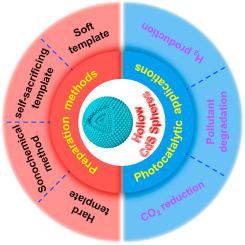Journal of Materiomics ( IF 8.4 ) Pub Date : 2020-10-27 , DOI: 10.1016/j.jmat.2020.10.010 Xiangyu Liu , Mahmoud Sayed , Chuanbiao Bie , Bei Cheng , Biwei Hu , Jiaguo Yu , Liuyang Zhang

|
In recent years, photocatalytic technology, driven by solar energy, has been extensively investigated to ease energy crisis and environmental pollution. Nevertheless, efficiency and stability of photocatalysts are still unsatisfactory. To address these issues, design of advanced photocatalysts is important. Cadmium sulphide (CdS) nanomaterials are one of the promising photocatalysts. Among them, hollow-structured CdS, featured with enhanced light absorption ability, large surface area, abundant active sites for redox reactions, and reduced diffusion distance of photogenerated carriers, reveals a broad application prospect. Herein, main synthetic strategies and formation mechanism of hollow CdS photocatalysts are summarized. Besides, we comprehensively discuss the current development of hollow-structured CdS nanomaterials in photocatalytic applications, including H2 production, CO2 reduction and pollutant degradation. Finally, brief conclusions and perspectives on the challenges and future directions for hollow CdS photocatalysts are proposed.
中文翻译:

空心CdS基光催化剂
近年来,已经广泛研究了由太阳能驱动的光催化技术,以缓解能源危机和环境污染。然而,光催化剂的效率和稳定性仍然不能令人满意。为了解决这些问题,高级光催化剂的设计很重要。硫化镉(CdS)纳米材料是有前途的光催化剂之一。其中,中空结构的CdS具有增强的光吸收能力,大的表面积,丰富的氧化还原反应活性位点和减小的光生载流子扩散距离等特点,具有广阔的应用前景。本文概述了空心CdS光催化剂的主要合成策略和形成机理。除了,2生产,CO 2减少和污染物降解。最后,对空心CdS光催化剂的挑战和未来方向提出了简短的结论和展望。











































 京公网安备 11010802027423号
京公网安备 11010802027423号